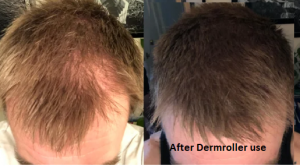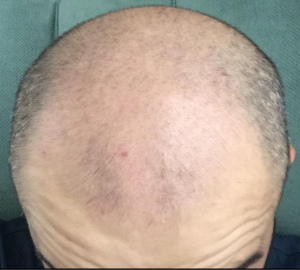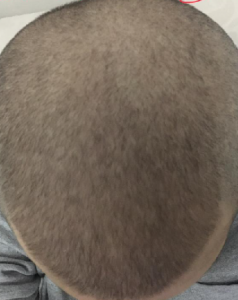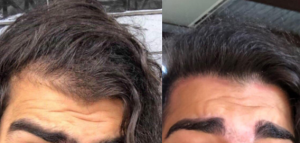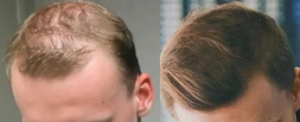Finasteride, Propecia and Duasteride labels warn that pregnant women must not be exposed to the drug. This includes by taking it, touching a tablet, or by being exposed to semen from a man who is taking it.1
This is because if the active ingredient in Finasteride is absorbed by a woman who is pregnant with a male baby, it can cause the male baby to be born with abnormalities of the sex organs. Finasteride blocks DHT, which is necessary for male baby organs to form and grow. Prenatal Finasteride exposure has also been shown to affect cognitive function in both male and female babies.
What are the specific problems? According to the research they include:
-
Higher rates of miscarriage
-
A small penis
-
Hypospadias
-
A small underdeveloped scrotum
-
A prominent midline raphe (scrotum doesn’t join normally)
-
Ectopic testicles (which don’t reach the scrotum)
-
Cognitive problems in both males AND females
-
Memory problems in both males AND females
Three sources detailing these effects are provided below.
Source 1: S. Prahalada (1997) Effects of Finasteride, a Type 2 5-Alpha Reductase Inhibitor, on Fetal Development in the Rhesus Monkey2
In this study pregnant female monkeys were orally given 2mg/kg/day. Every single one of their male babies had genital birth defects.
“The male external genital anomalies were characterised by hypospadias which were confined to the glans penis (5/6; 83.3%), preputial adhesion to the glans (6/6; 100%), a small underdeveloped scrotum (6/6; 100%), a small penis (5/6; 100%) and a prominent midline raphe (6/6; 100%).”
“An apparent incidence in the fetal loss rate was observed in the 2mg/kg/day (23.1%) and the 800ng/kg/day (20%) finasteride treated groups when compared to concurrent controls…”
Source 2: Christopher Bowman, et al (2003). Effects of in Utero Exposure to Finasteride on Androgen-Dependent Reproductive Development in the Male Rat3
In this study Finasteride is shown to impact testicular descent: “Prenatal finasteride exposure significantly impaired testicular descent. Approximately 3, 23, and 73% of the adult males displayed ectopic testes in the 1.0, 10, and 100 mg/kg/day dose groups, respectively… The data from the current study suggest that the conversion of T to DHT in the developing gubernaculum is necessary for normal testicular descent.”
Even in the smallest dose of 0.01 mg/kg/day in the last stages of gestation there were genital issues affecting anogenital distance (AGD) of the males after the rats were born. “Late gestational exposure to finasteride significantly decreased AGD of male offspring in a dose-responsive manner… the AGD of male offspring displayed significant decreases of 8, 16, 23, 25, and 33% in the 0.01, 0.1, 1.0, 10, and 100 mg/kg/day dose groups, respectively.”
“The dose-response curves for finasteride-induced malformations fell into two groups. External structural changes such as decreased AGD and increased nipple retention had similar dose-response curves. These external changes were almost linear over the entire dose range (0.01 to 100 mg/kg/day) and approached 100% incidence by the highest dose.”
The authors note that “The lack of a no observed effect level (NOEL) in the current study was consistent” with the study by Clark (1990) which showed effects at doses down to 0.003 mg/kg/day. (DR RASSMAN’S COMMENT: THIS STUDY WAS DONE IN MONKEYS ADMINISTERED FINASTERIDE IN VARIOUS DOSES DURING PREGNANCY. THIS IS NOT THE SAME AS THE MALE MONKEY BEING ON FINASTERIDE WHEN THE FEMALE MONKEY BECAME PREGNANT)
Source 3: Jason Paris et al (2012) Inhibition of 5?-reductase activity in late pregnancy decreases gestational length and fecundity and impairs object memory and central progestogen milieu of juvenile rat offspring4
“Finasteride significantly reduced the length of gestation and the number of pups per litter…”
“Prenatal finasteride treatment significantly reduced object recognition, decreased hippocampal 3?,5?-THP content… inhibiting the formation of 5?-reduced steroids during late gestation in rats reduces gestational length, the number of viable pups per litter, and impairs cognitive and neuroendocrine function in the juvenile offspring.” (THIS STUDY WAS DONE IN RATS, AGAIN IN PREGNANCY AND DOES NOT CORRESPOND TO A MALE RAT TAKING FINASTERIDE WHEN THE FEMALE RAT BECAME PREGNANT)
While some of these research exposures were a lot higher than would be expected from semen exposure, don’t risk exposing a baby to any amount of this extremely dangerous US FDA pregnancy category X drug.5 Studies have demonstrated fetal abnormalities and there is positive evidence of human fetal risk.
Links:
1.https://www.drugs.com/pregnancy/finasteride.html#:~:text=-Finasteride%20is%20present%20in%20semen,wishing%20to%20conceive%20a%20child
2.https://www.docme.su/doc/1721148/effects-of-finasteride–a-type-2-5-alpha-reductase-inhibi…
3.https://academic.oup.com/toxsci/article/74/2/393/1716348
4.https://www.ncbi.nlm.nih.gov/pmc/articles/PMC3196810/#__ffn_sectitle
5.https://www.google.com/url?sa=t&source=web&rct=j&url=https://www.accessdata.fda.gov/drugsatfda_docs/label/2012/020788s020s021s023lbl.pdf&ved=2ahUKEwi5iY7a3_bpAhUvyDgGHVP2AIEQFjABegQICxAG&usg=AOvVaw1iQoISJACkyba4PNH1LzZM

